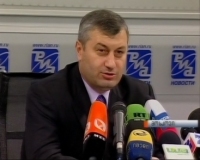
Moscow and Tskhinvali Finally Agree Russian Federal Aid Deal for South Ossetia
Publication: Eurasia Daily Monitor Volume: 6 Issue: 65
By:

It took an eleventh-hour lobbying effort by the separatist leader of South Ossetia Eduard Kokoity to avert a serious fiscal crisis in the breakaway republic. On March 26, Kokoity led a delegation from South Ossetia to meet the Minister of Regional Development, Victor Basargin and representatives from Russia’s audit agency -the Accounts Chamber of the Russian Federation (Vedomosti, March 27; www.polit.ru, March 27). This was immediately followed by a meeting of the interagency commission, established under the aegis of the Ministry of Regional Development on August 18, 2008, as a primarily consultative body responsible for overseeing the reconstruction efforts in South Ossetia (Vedomosti, March 16). Prior to this, the scheduled meetings of the interagency commission were postponed on at least four occasions, including February 27 and March 16, because the Russian Finance Ministry representative failed to attend (Vedomosti, March 16; www.lenta.ru, March 16; Kommersant, March 16, 18).
A consensus was reached on Russian’s fiscal priorities for funding the program of reconstruction work planned for. The agreement was consistent with the recommendations issued by the Accounts Chamber last December. That set of recommendations stemmed from the first audit carried out in South Ossetia by Russian auditors over a three week period in November (Kommersant, December 25, 2008). In particular, the Accounts Chamber proposed to replace the interagency commission with the Federal Directorate for Reconstruction of South Ossetia, which is now being formed in Moscow under the aegis of the Ministry of Regional Development.
Although the directorate is supposed to function in close coordination with South Ossetia’s authorities, its establishment reflects the Russian government’s weariness with Kokoity’s corrupt regime and its willingness to strictly control the flow of federal funds. The Accounts Chamber’s press release indicated that out of the overall 1.5 billion rubles pledged, South Ossetia received only 550 million rubles ($16 million); of which only 50 million rubles ($1.5 million) had been spent when the audit was conducted (Lenta.ru, December 25, 2008; The New York Times, March 7, 2009).
The combination of the impact of the global financial crisis and the audit by the Accounts Chamber prompted the Russian Finance Ministry in January and February to freeze all funds intended for South Ossetia. The sudden suspension of funds fully exposed South Ossetia’s dependence on continuous Russian subsidies, as the separatist government was unable to pay salaries, stipends, pensions, and benefits to the population, including its own officials. Fearing social unrest and a possible collapse of Kokoity’s government, Russia’s Finance Ministry finally approved the disbursement of a 5.16 billion rubles ($153 million) combined financial aid package for Georgia’s breakaway regions on March 16 (www.civil.ge, March 17; Kommersant, March 18). Of this amount, 2.8 billion rubles ($83 million) was allocated for South Ossetia and 2.36 billion rubles ($70 million) for Abkhazia (www.civil.ge, March 17). The inclusion of Abkhazia was not coincidental since the Kremlin was trying to avoid favoritism between the two. None of these funds are for the reconstruction efforts, and, according to the Russian Finance Ministry, they are to be spent "on social-economic development and maintaining balanced budgets" in Abkhazia and South Ossetia, which is a thinly veiled admission of their status as de facto dependent territories (Kommersant, March 18).
Meanwhile, since January much of the reconstruction work in South Ossetia has been mothballed due to the failure of Moscow and Tskhinvali to agree on a mechanism for its financing. On March 16, the Minister of Press and Mass Media of South Ossetia, Irina Gagloeva contacted Reuters to complain about Russia reneging on its commitment to rebuild South Ossetia. Gagloeva said that eight months after the war thousands of civilians remained homeless or lived in damaged houses because the aid promised by Russia had been largely undelivered. She noted, "There are only two or three buildings that have been completely restored. About 10 percent has been partially restored. Everything else is in the same condition as it was after the Georgian aggression. There is not a single construction worker here in [South] Ossetia. They all have left because they are not being paid" (Reuters, March 16). Gagloeva went further with the Russian press, when she told Kommersant that since the end of the war the separatist enclave lived basically "under conditions of a humanitarian catastrophe" (Kommersant, March 16).
The resolution of the dispute over a funding mechanism will only bring a modicum of hope to South Ossetia, which is being rapidly depopulated due to the absence of the most basic living conditions, including running water, electricity, heating, etc. In the best case scenario, the reconstruction work will resume only by summer (Kommersant, March 16, 18). The Kremlin is belatedly realizing that by recognizing South Ossetia’s independence it now faces a conundrum of inadvertent state-building. The establishment of the federal directorate for financing, monitoring and controlling the reconstruction work in South Ossetia is a clear step towards the creation of a colonial administration. Thus, despite the artificial trappings of a newly independent state, South Ossetia will be a "black hole" in the Russian budget for the foreseeable future.




